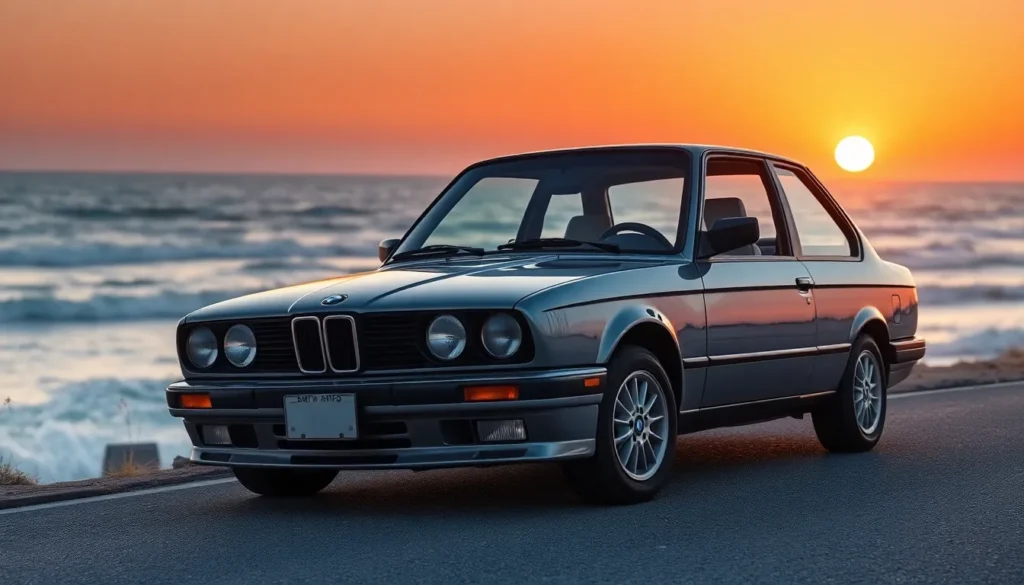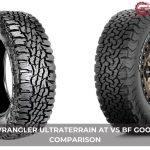The BMW E30 coupe stands as one of the most beloved and iconic sports cars ever created. We’ve witnessed countless automotive legends rise and fall over the decades but few have captured enthusiasts’ hearts quite like this German masterpiece from the 1980s and early 1990s.
What makes the E30 coupe so special? We’re talking about perfect proportions timeless design and an driving experience that modern cars struggle to replicate. This isn’t just nostalgia talking – the E30’s rear-wheel-drive layout precise steering and balanced chassis created a connection between driver and machine that’s become increasingly rare in today’s automotive industry.
Whether you’re considering buying your first E30 coupe or you’re a longtime owner looking to deepen your knowledge we’ll explore everything that makes this BMW a true enthusiast’s dream. From its racing pedigree to restoration tips the E30 coupe continues to prove why it’s earned its place in automotive history.
BMW E30 Coupe Overview and History
BMW launched the E30 coupe in 1982 as part of the 3 Series lineup, marking a pivotal moment in automotive design. The E30 coupe represented BMW’s commitment to creating an affordable yet sophisticated sports car that maintained the brand’s performance heritage.
Production of the BMW E30 coupe spanned from 1982 to 1994, during which BMW manufactured approximately 2.3 million E30 vehicles across all body styles. The coupe variant accounted for roughly 40% of total E30 production, making it one of the most popular configurations.
Design philosophy behind the E30 coupe emphasized clean lines and functional aerodynamics. BMW’s design team created distinctive kidney grilles, angular headlights, and muscular wheel arches that defined the car’s aggressive stance. The coupe’s profile featured a long hood, short deck proportions that became synonymous with BMW’s sporting character.
Engine options for the E30 coupe varied significantly across different markets and production years. European models received the powerful M20 inline-six engines, while North American versions initially featured the M10 four-cylinder units. BMW introduced the legendary S14 engine in the M3 variant, producing 200 horsepower in its original European specification.
Market reception of the E30 coupe exceeded BMW’s expectations, with automotive journalists praising its balance of performance and practicality. The car earned recognition for its precise handling characteristics and build quality that surpassed many competitors in the compact sports car segment.
Racing success defined much of the E30 coupe’s reputation, particularly through the M3’s dominance in touring car championships. BMW’s motorsport division developed the M3 specifically for Group A racing requirements, resulting in multiple championship victories across Europe and North America between 1987 and 1992.
Technical innovations within the E30 coupe included advanced suspension geometry and weight distribution optimization. BMW engineers positioned the engine behind the front axle line, achieving a near-perfect 50:50 weight distribution that enhanced the car’s ever-changing capabilities on both road and track.
Design and Exterior Features
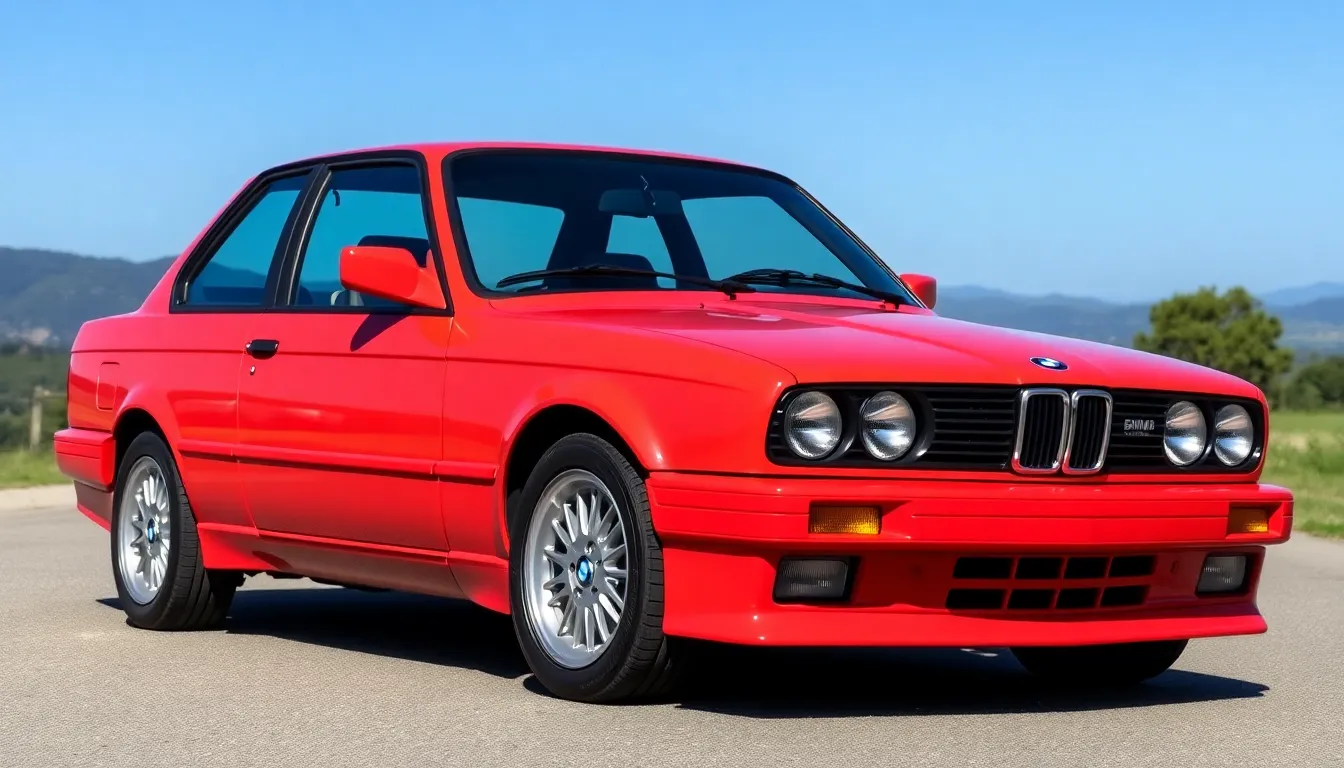
The BMW E30 coupe’s design remains a masterpiece of automotive aesthetics that defined the sports car look of the 1980s. Every element of its exterior showcases the perfect balance between aggressive stance and elegant sophistication.
Classic 1980s Styling
We recognize the E30 coupe’s design as the definitive expression of 1980s BMW styling philosophy. Angular headlights create a sharp, focused appearance that immediately distinguishes it from contemporary vehicles. The iconic kidney grilles sit prominently at the front, measuring 6.5 inches in height and featuring black slats that emphasize the car’s sporting character.
Chrome trim accents run along the window frames and door handles, adding refinement without compromising the aggressive aesthetic. Side marker lights integrate seamlessly into the front bumper design, while the rear features distinctive taillights with geometric patterns typical of the era. Body-colored bumpers replaced the earlier chrome versions in 1987, creating a more cohesive visual flow.
The hood features subtle power bulges that hint at the performance potential beneath, while the rear spoiler on sport models adds functional aerodynamic enhancement. Window proportions maintain the classic BMW greenhouse design with relatively thin pillars that maximize visibility for the driver.
Body Lines and Proportions
We observe that the E30 coupe’s proportions create an ideal sports car silhouette with a long hood and short deck configuration. The wheelbase measures 100.4 inches, providing optimal weight distribution between the front and rear axles. Overall length reaches 171.3 inches, while the height of 54.1 inches creates a low, purposeful stance.
| Dimension | Measurement |
|---|---|
| Wheelbase | 100.4 inches |
| Overall Length | 171.3 inches |
| Overall Width | 65.9 inches |
| Height | 54.1 inches |
Sharp character lines run from the front wheel arches to the rear taillights, creating visual tension along the car’s profile. The beltline rises gently toward the rear, emphasizing the coupe’s sporting intentions. Door handles sit flush with the bodywork, maintaining clean aerodynamic surfaces.
Wheel arch flares accommodate various wheel sizes from 14 to 16 inches depending on the model variant. The roofline slopes gracefully from the A-pillar to create an elegant fastback profile without compromising rear passenger headroom. Ground clearance measures 5.3 inches, allowing for spirited driving while maintaining everyday usability.
Front and rear overhangs remain minimal, contributing to the car’s balanced appearance and optimal approach angles. The side glass area maintains generous proportions that enhance the airy cabin feel even though the coupe configuration.
Interior and Cabin Experience
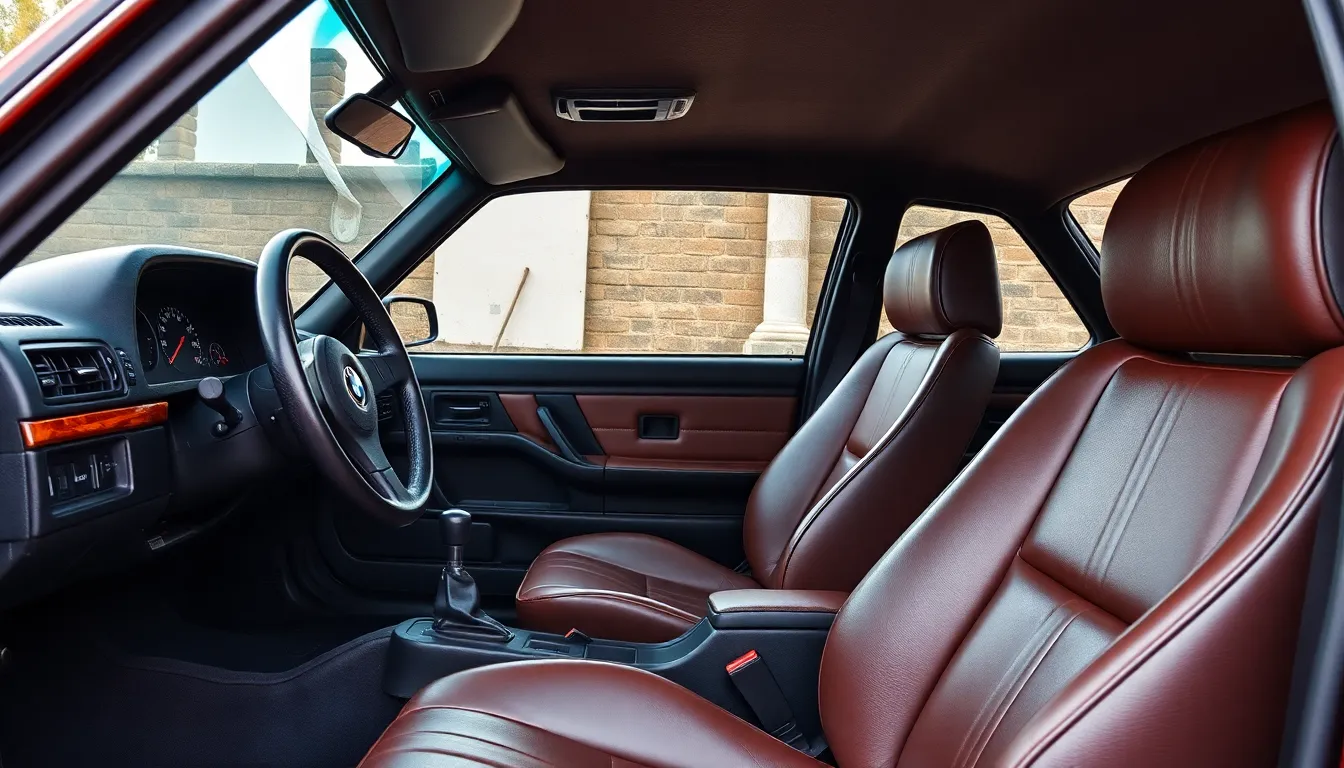
BMW E30 coupe interiors combine German engineering precision with 1980s automotive luxury. The cabin design prioritizes driver engagement while maintaining the practical functionality that defined the 3 Series lineup.
Seating and Comfort
Sport seats in the E30 coupe feature pronounced side bolsters that provide excellent lateral support during aggressive cornering. Factory upholstery options included durable cloth patterns and premium leather surfaces that developed a distinctive patina over time. Front seat adjustment ranges accommodate drivers from 5’4″ to 6’2″ comfortably with manual controls for height and rake positioning.
Rear seating accommodates two adult passengers even though the coupe’s sporting proportions. Legroom measures 32.1 inches behind the front seats when positioned for average-height drivers. The split-folding rear bench expands cargo capacity from 13.8 cubic feet to over 40 cubic feet with seats lowered.
Heated seats appeared as standard equipment on luxury trim levels and optional packages. The heating elements warm seats within 2-3 minutes of activation during cold weather conditions. Seat materials resist wear exceptionally well with many original interiors maintaining their appearance after 30+ years of use.
Dashboard and Controls
The driver-focused dashboard layout places essential controls within easy reach of the steering wheel. Instrument cluster visibility remains excellent with large analog gauges for speedometer, tachometer, fuel level, and engine temperature. Warning lights use clear iconography that BMW drivers recognize instantly across model generations.
Climate controls feature simple rotary dials and slider mechanisms that operate HVAC functions reliably. Air conditioning systems in North American models use R12 refrigerant that requires professional conversion to modern R134a systems. Ventilation ducts direct airflow precisely with adjustable louvers at dashboard corners and center console positions.
Radio integration varies by model year with early cars featuring basic AM/FM units and later models offering cassette players. The center console houses radio controls alongside lighter socket and small storage compartments. Modern owners frequently upgrade audio systems while preserving the original dashboard appearance through careful component selection and professional installation techniques.
Engine Options and Performance
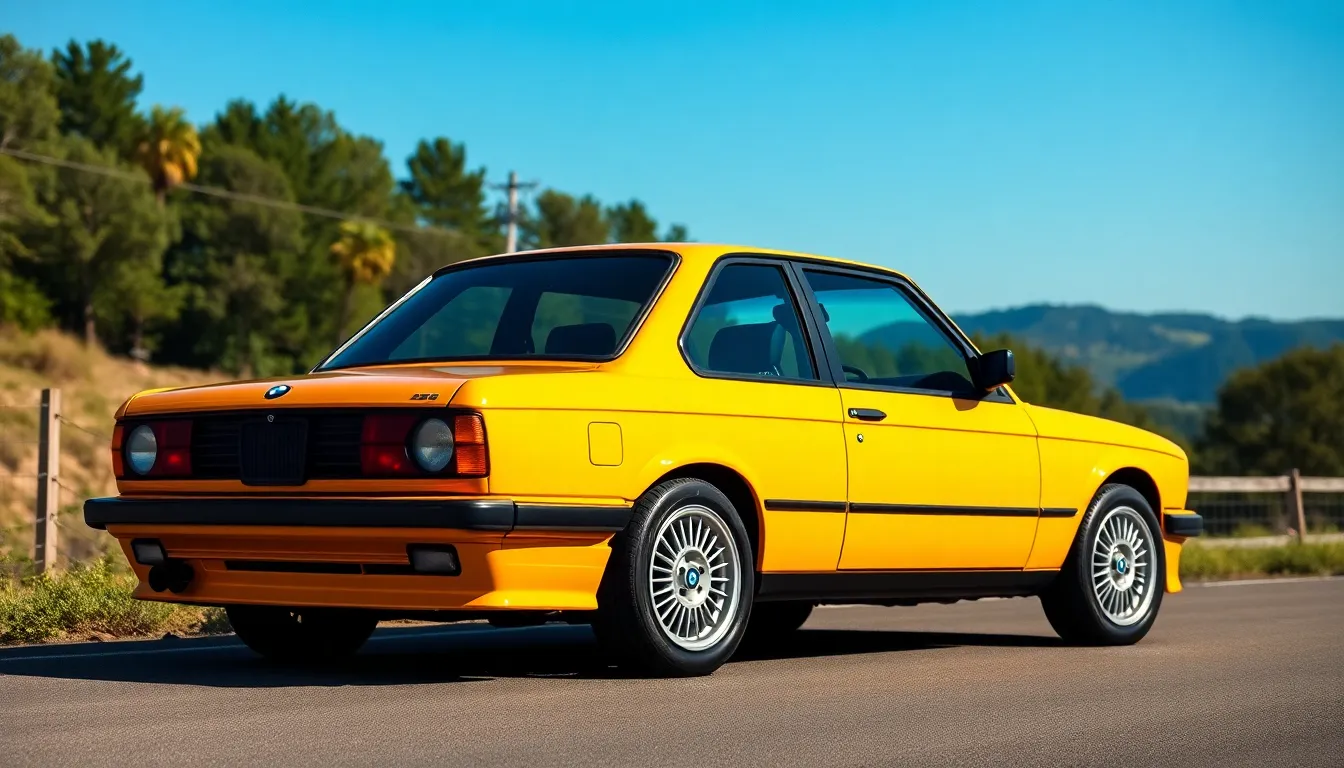
The BMW E30 coupe offered a diverse range of powerplants that defined its character and performance capabilities. Engine configurations varied significantly across markets and model years, providing options for both efficiency-focused drivers and performance enthusiasts.
Base Engine Specifications
Base engine options in the E30 coupe lineup delivered reliable power across multiple displacement categories. The M10 four-cylinder engines served as entry-level powerplants in many markets, producing outputs ranging from 90 to 125 horsepower depending on the exact variant. European markets received the coveted M20 inline-six engines, which became the backbone of the E30’s performance reputation.
The M20B20 2.0-liter inline-six generated 125 horsepower and 122 lb-ft of torque, offering smooth power delivery and excellent fuel economy. Higher-performance variants included the M20B25 2.5-liter engine, producing 168 horsepower and 164 lb-ft of torque in naturally aspirated form. North American markets typically received different engine configurations due to emissions regulations, including the M20B27 2.7-liter variant that compensated for power losses from catalytic converters.
Transmission options included five-speed manual gearboxes as standard equipment, with four-speed automatic transmissions available on select models. The manual transmissions featured close-ratio gearing that complemented the engines’ power bands perfectly. Fuel injection systems varied by engine type, with Bosch Motronic engine management controlling fuel delivery and ignition timing on later models.
M3 Performance Variant
The M3 variant represented the pinnacle of E30 coupe performance engineering. BMW’s motorsport division developed the S14 2.3-liter four-cylinder engine specifically for homologation purposes in touring car racing. This naturally aspirated powerplant produced 195 horsepower and 170 lb-ft of torque in European specification, utilizing a 16-valve DOHC configuration with individual throttle bodies.
Performance figures for the M3 included a 0-60 mph acceleration time of 6.5 seconds and a top speed of 143 mph. The S14 engine featured forged internals, aggressive camshaft profiles, and a 10.5:1 compression ratio that required premium fuel. Cooling systems received upgrades to handle the increased thermal loads, including larger radiators and improved airflow management.
The M3’s transmission consisted of a close-ratio Getrag five-speed manual gearbox designed to handle the engine’s output characteristics. Final drive ratios were optimized for both acceleration and top speed performance. Limited-slip differential systems came standard on M3 models, distributing power effectively during cornering and acceleration phases.
Evolution variants of the M3 received further engine enhancements throughout the production run. The Sport Evolution model featured a larger 2.5-liter S14B25 engine producing 238 horsepower and 177 lb-ft of torque. These final production M3 coupes represented the ultimate expression of E30 performance capabilities.
Driving Dynamics and Handling
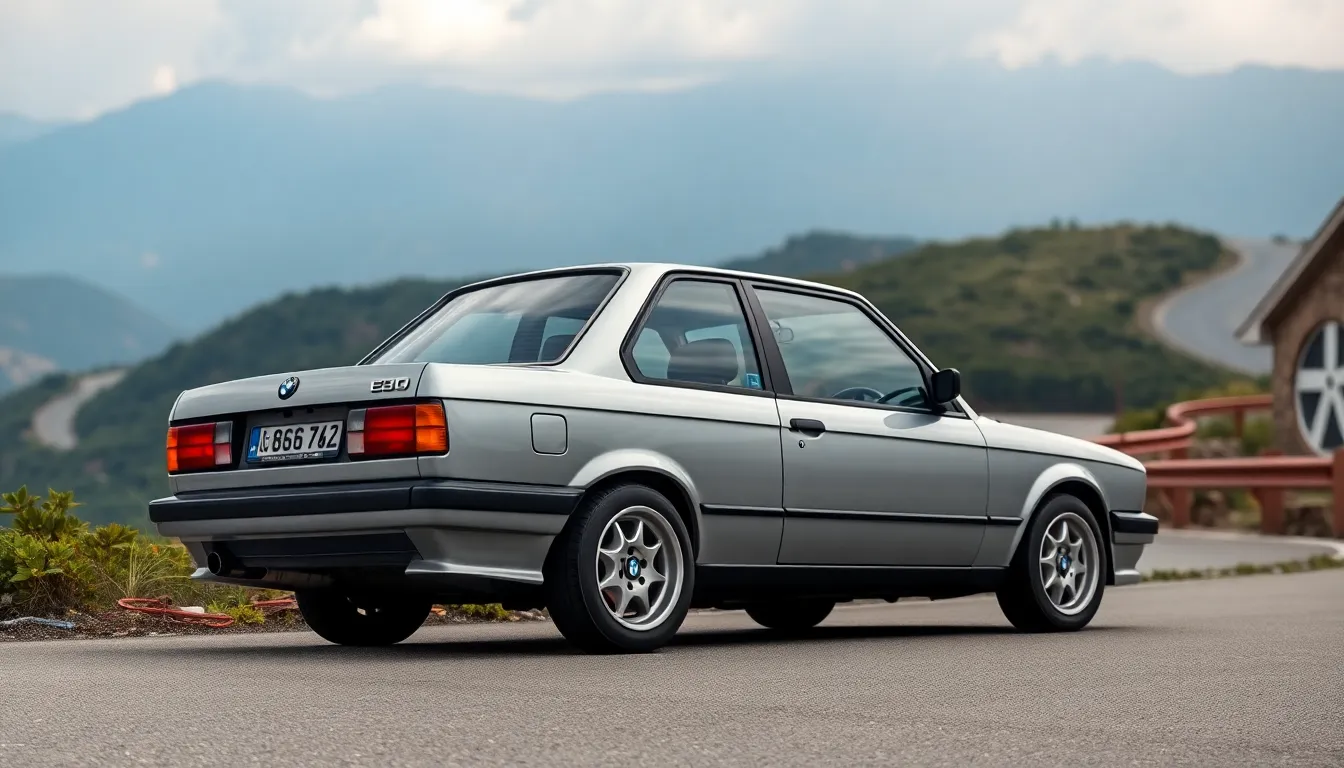
Driving dynamics represent the E30 coupe’s greatest achievement, transforming mechanical components into an captivating automotive experience. The rear-wheel drive configuration places power delivery exactly where enthusiasts expect it, creating natural weight transfer characteristics that enhance cornering confidence.
Weight distribution measures 50.7% front and 49.3% rear in standard models, providing exceptional balance through corners and under braking. MacPherson strut front suspension combines with semi-trailing arm rear geometry to deliver precise steering response and predictable handling limits. The suspension setup maintains composure during aggressive driving while offering acceptable ride quality for daily use.
Steering precision ranks among the E30’s most celebrated attributes, with the recirculating ball system providing direct feedback from the road surface. Turn-in response feels immediate and progressive, allowing drivers to place the vehicle exactly where intended through corner sequences. The steering ratio varies between 15.2:1 and 19.1:1 depending on the exact model and year.
| Handling Specification | Standard E30 | M3 Variant |
|---|---|---|
| Weight Distribution | 50.7/49.3 | 51.3/48.7 |
| Front Track Width | 55.1 inches | 56.9 inches |
| Rear Track Width | 55.5 inches | 57.1 inches |
| Curb Weight | 2,570-2,750 lbs | 2,866 lbs |
Chassis rigidity enables the suspension to work effectively, with the unibody construction providing sufficient structural integrity for spirited driving. Body flex remains minimal even during track sessions, maintaining consistent suspension geometry throughout the vehicle’s range of motion. The low center of gravity contributes to the coupe’s stable platform during direction changes.
Braking performance utilizes ventilated front discs on most models, with solid rear discs providing adequate stopping power for the vehicle’s weight. ABS became available on later models, though many enthusiasts prefer the direct pedal feel of non-ABS systems. Brake bias favors the front wheels appropriately, preventing premature rear lockup during hard stops.
The M3 variant elevates these characteristics through wider tracks, lower ride height, and revised suspension tuning. Sport-tuned dampers and springs reduce body roll while maintaining wheel contact during aggressive cornering. Limited-slip differential options enhance traction under acceleration, particularly when exiting corners with throttle applied.
Tire options significantly influence the E30’s ever-changing behavior, with period-correct sizes ranging from 185/65R14 to 225/45R16 on M3 models. Modern tire compounds provide substantially more grip than original equipment, transforming the vehicle’s performance envelope while maintaining its characteristic balance and feedback.
Common Issues and Reliability
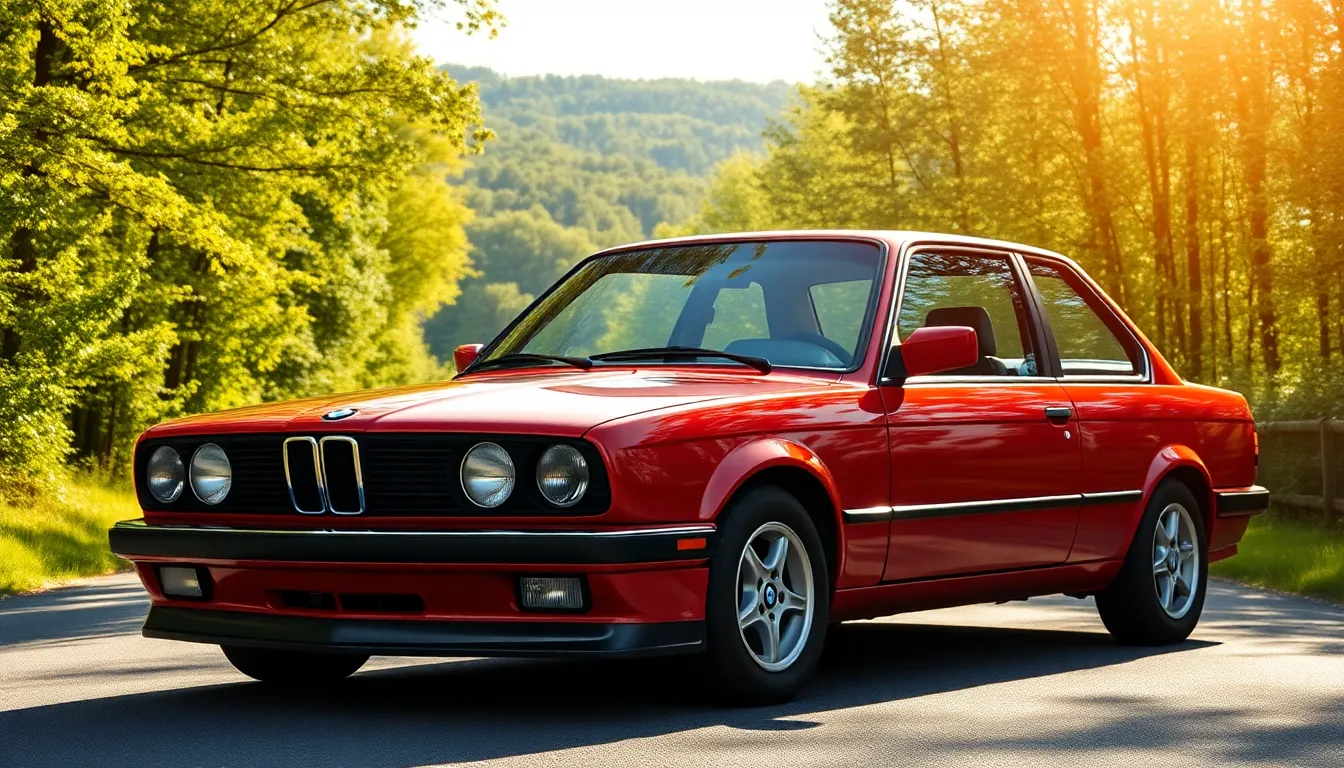
The E30 coupe demonstrates remarkable longevity for a vehicle from the 1980s when properly maintained. Exact mechanical issues affect these models due to age rather than inherent design flaws.
Known Problem Areas
Suspension Components deteriorate predictably after three decades of service. Front control arm bushings wear out first, causing excessive tire wear and compromised handling precision. Rear semi-trailing arm bushings follow a similar pattern, creating noticeable rear-end instability during cornering. Shock absorbers lose damping effectiveness after 80,000 miles in most cases.
Cooling System Failures plague E30 coupes with aging plastic components. Radiators crack at the plastic end tanks around the 20-year mark, while water pumps fail between 60,000 and 100,000 miles. Expansion tanks develop stress fractures that cause coolant leaks and overheating issues. Thermostat housings made from plastic crack frequently, requiring complete replacement.
Electrical Gremlins emerge from deteriorating wiring harnesses and oxidized connectors. Power window motors fail in 60% of vehicles over 25 years old, while central locking systems malfunction due to vacuum pump deterioration. Dashboard warning lights activate randomly when printed circuit boards develop micro-cracks. Alternator brushes wear down after 120,000 miles on average.
Engine Oil Leaks develop at valve cover gaskets and oil pan seals as rubber components age. Camshaft position sensor O-rings fail on M20 engines after 100,000 miles, causing rough idle conditions. Crankcase ventilation systems clog with carbon deposits, increasing internal pressure and accelerating seal degradation.
Maintenance Requirements
Scheduled Service Intervals differ significantly from modern BMW recommendations due to older oil formulations and tighter tolerances. Oil changes occur every 3,000 miles using conventional motor oil or every 5,000 miles with synthetic alternatives. Valve adjustments on M10 engines require attention every 15,000 miles to maintain proper compression.
Critical Fluid Replacements extend component lifespan dramatically when performed proactively. Brake fluid changes every 2 years prevent internal corrosion of expensive ABS components found on later models. Coolant replacement every 3 years using BMW-approved antifreeze prevents aluminum corrosion in the cylinder head. Differential oil changes every 30,000 miles protect the limited-slip differential found in sport packages.
Preventive Component Updates address known failure points before catastrophic damage occurs. Cooling system overhauls at 100,000-mile intervals replace all plastic components simultaneously, reducing future breakdown risks. Suspension refresh projects tackle bushings, shocks, and springs as complete assemblies rather than individual repairs. Fuel system cleaning removes varnish deposits from injectors and fuel rails every 40,000 miles.
Inspection Points require monthly attention to catch developing problems early. Tire wear patterns reveal alignment issues or worn suspension components before they affect safety. Under-hood inspections identify oil seeps before they become major leaks requiring expensive repairs. Battery terminals require cleaning every 6 months to prevent electrical issues from poor connections.
Market Value and Collectibility
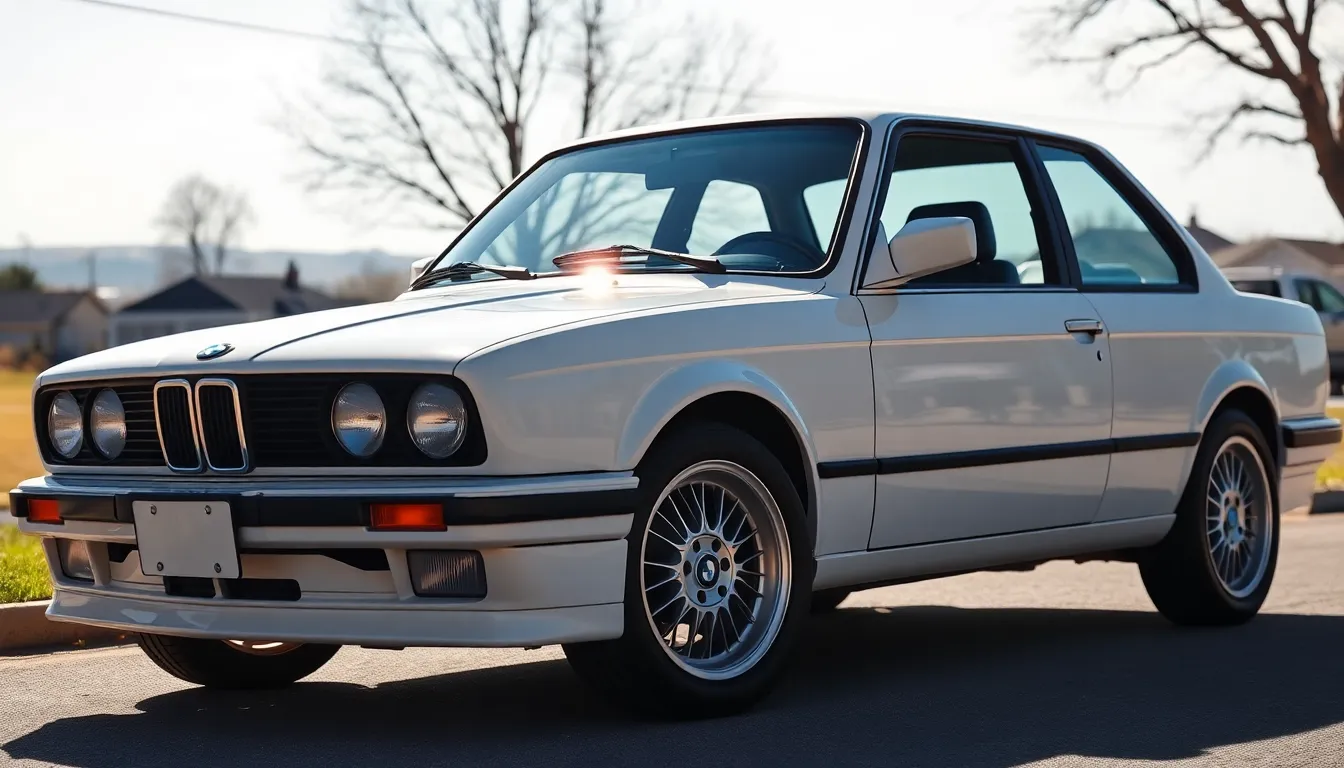
BMW E30 coupes have experienced remarkable appreciation in collector car markets over the past decade. Standard models that sold for $3,000-8,000 in the early 2000s now command $15,000-35,000 depending on condition and specification. Clean examples with documented maintenance histories consistently outperform vehicles with questionable provenance.
Current Market Pricing
| Model Variant | Condition | Price Range |
|---|---|---|
| 325i/325is | Good | $15,000-25,000 |
| 325i/325is | Excellent | $25,000-35,000 |
| M3 Standard | Good | $45,000-65,000 |
| M3 Standard | Excellent | $65,000-85,000 |
| M3 Sport Evolution | Any | $150,000-250,000 |
Factors Affecting Value
Original paint significantly impacts E30 coupe values, with factory colors like Alpine White and Brilliant Red commanding premiums over repainted examples. Documentation proves crucial for establishing authenticity, particularly for M3 variants where matching numbers engines and transmissions add substantial value. Rust-free examples from dry climates consistently sell for 20-30% more than comparable vehicles with bodywork repairs.
Investment Potential
European specification models increasingly attract American collectors due to their higher performance engines and unique features unavailable in US-market cars. Federal legalization of 25-year-old imports has opened new collecting opportunities, with clean European M3s fetching premium prices at auction. Sport Evolution models represent the ultimate E30 collectible, with their limited production run of 600 units ensuring continued appreciation.
Regional Market Variations
West Coast markets traditionally show higher prices for E30 coupes due to better preservation conditions and stronger enthusiast communities. East Coast examples often require more extensive restoration work, creating opportunities for buyers willing to invest in proper refurbishment. International markets, particularly in Japan and Australia, have driven up values for clean examples as local supply diminishes.
Collector Grade Examples
Mint condition E30 coupes with under 50,000 miles now achieve prices that seemed impossible just five years ago. Original window stickers, dealer documentation, and service records transform good cars into exceptional investments. Time capsule examples with original accessories like tool kits and spare keys represent the pinnacle of E30 collectibility.
Buying Guide and What to Look For
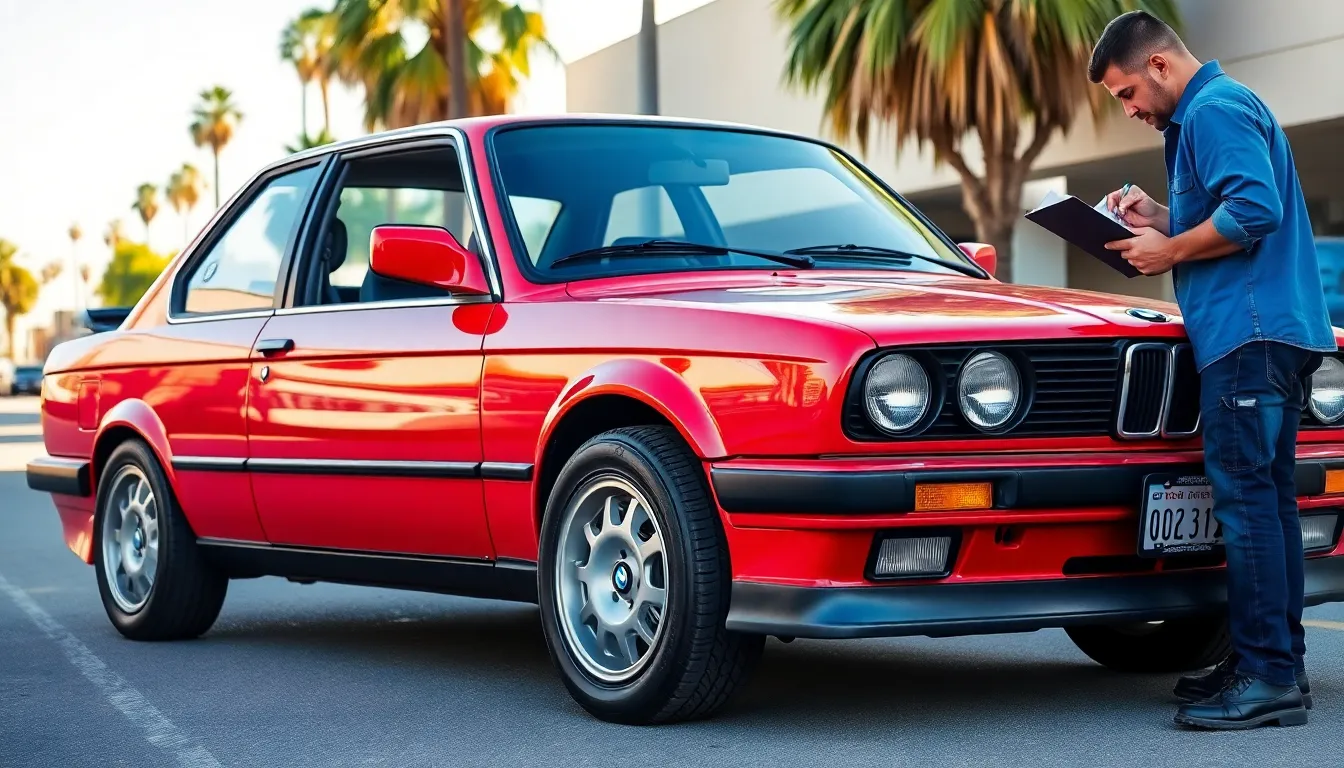
Purchasing a BMW E30 coupe requires careful inspection and understanding of common problem areas that affect these classic vehicles. We recommend examining structural integrity first, as rust represents the most important threat to E30 ownership. Check the rear shock towers, front strut towers, and door frames for corrosion damage that can compromise safety and require expensive repairs.
Critical Inspection Points:
| Component | What to Check | Red Flags |
|---|---|---|
| Body Panels | Rust bubbles, accident damage | Misaligned gaps, paint mismatch |
| Suspension | Worn bushings, leaking shocks | Clunking sounds, uneven tire wear |
| Engine | Oil leaks, cooling system | White smoke, overheating history |
| Transmission | Smooth shifting, clutch wear | Grinding gears, slipping clutch |
| Electronics | Window motors, central locking | Non-functioning components |
Engine condition determines long-term reliability and performance potential in E30 coupes. M20 inline-six engines typically show oil leaks around the valve cover gasket and oil filter housing by 100,000 miles. Listen for timing chain rattle during cold starts, which indicates worn chain guides that require immediate attention.
Documentation proves essential when evaluating E30 coupe value and authenticity. Original service records demonstrate proper maintenance history, while build sheets verify factory specifications and options. European delivery models often command premium pricing but require verification through BMW Classic documentation.
Interior wear patterns reveal actual usage and care levels beyond odometer readings. Sport seats should maintain proper bolster support without excessive sagging or torn upholstery. Dashboard cracks commonly appear on models exposed to direct sunlight, particularly affecting resale value.
Mechanical systems require thorough testing during inspection visits. We suggest operating all electrical components including lights, windows, sunroof, and climate control systems. Suspension components wear predictably, with control arm bushings and shock absorbers requiring replacement every 80,000-120,000 miles depending on driving conditions.
Budget Planning Considerations:
Immediate repairs often total $2,000-5,000 for typical E30 coupes requiring attention after purchase. Preventive maintenance items include cooling system overhauls ($800-1,200), suspension refreshes ($1,500-2,500), and brake system updates ($600-1,000). Factor these costs into your purchase decision to avoid budget surprises.
Rust-free examples from Southern California or Arizona markets justify premium pricing compared to Northeastern vehicles with winter road salt exposure. Single-owner vehicles with continuous maintenance records typically offer better long-term value than multiple-owner examples with gaps in service history.
Professional pre-purchase inspections provide detailed assessments of mechanical condition and help negotiate fair pricing. BMW specialists familiar with E30 platforms can identify potential problems that general mechanics might overlook, particularly about cooling system integrity and electrical system functionality.
Conclusion
The BMW E30 coupe remains one of automotive history’s most rewarding ownership experiences. We’ve seen how this iconic machine combines timeless design with exceptional driving dynamics that modern cars struggle to replicate.
Whether you’re considering your first E30 purchase or already own one of these classics the investment continues to prove worthwhile. Market values show no signs of declining and the passionate community surrounding these vehicles ensures parts availability and technical knowledge remain strong.
We believe the E30 coupe represents the perfect entry point into classic BMW ownership. Its blend of daily usability legendary handling and growing collector status makes it an automotive icon that’ll continue captivating enthusiasts for generations to come.
Frequently Asked Questions
What is a BMW E30 coupe?
The BMW E30 coupe is an iconic sports car produced from 1982 to 1994 as part of BMW’s 3 Series lineup. It features rear-wheel drive, precise steering, and timeless 1980s design with distinctive kidney grilles and angular headlights. The coupe variant represented about 40% of the 2.3 million E30 vehicles manufactured, making it highly popular among enthusiasts.
What engine options were available in the E30 coupe?
The E30 coupe offered various engines including M10 four-cylinder and M20 inline-six engines with outputs ranging from 90 to 168 horsepower. The high-performance M3 variant featured the legendary S14 2.3-liter engine producing 195 horsepower, while the Sport Evolution model had a 2.5-liter version generating 238 horsepower.
How much does a BMW E30 coupe cost today?
Current market prices range from $15,000-35,000 for standard models, representing significant appreciation from their previous $3,000-8,000 values. High-performance M3 variants and collector-grade examples command much higher prices. European specification models and limited production variants like the Sport Evolution are particularly valuable investments.
What are common problems with BMW E30 coupes?
Common issues include suspension component wear, cooling system failures, electrical problems, and engine oil leaks due to age. Regular maintenance is crucial, with immediate repair costs potentially ranging from $2,000-5,000. Rust is a major concern, especially in areas with harsh weather conditions.
What should I look for when buying an E30 coupe?
Inspect for rust, suspension wear, engine condition, and electrical functionality. Check documentation including service records and build sheets. Consider rust-free examples from warmer climates and single-owner vehicles with consistent maintenance records. Professional pre-purchase inspections by BMW specialists are highly recommended for thorough assessment.
Why is the BMW E30 coupe considered special?
The E30 coupe combines perfect proportions, timeless design, and exceptional driving dynamics with near-perfect 50/50 weight distribution. Its rear-wheel drive configuration, precise MacPherson strut suspension, and racing heritage (especially the M3’s touring car success) create a unique driving experience that’s difficult to find in modern vehicles.

